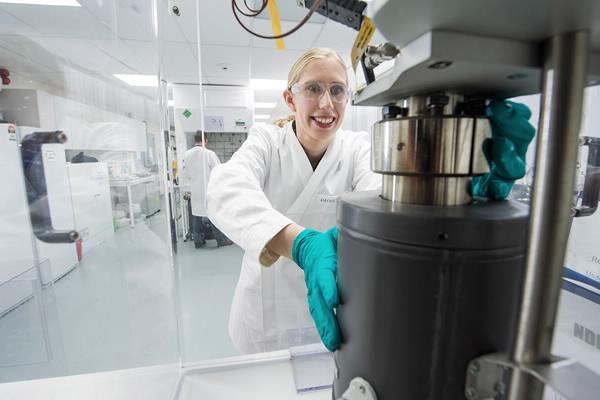

Published on the 7th May 2015 by ANSTO Staff
Chemists are interested in finding better, more efficient ways of producing chemicals, in processes that often have significant benefit for industry. In this case, research led to an improvement that may be of interest to chemical companies who produce organic compounds for the optoelectronics industry.

Dr Anwen Krause-Heuer is one of a number of researchers that have developed a general procedure using mild catalytic reactions and standard laboratory equipment to produce deuterated arylamines.
Organic chemists at the National Deuteration Facility at ANSTO have found a new method to produce bulk quantities of deuterated organic molecules (in which hydrogen atoms have been replaced with deuterium) using standard, inexpensive laboratory equipment instead of a highly specialised vessel capable of high temperatures and pressures.
This method was used to cheaply and simply synthesise a type of deuterated organic molecule intended for use in organic light emitting diodes (OLEDs). The research was presented in a recent paper published in the journal Molecules.
Some organic molecules have conductive properties needed for optoelectronic technologies in which light is emitted from materials stimulated by low level energy (electroluminescence), such as OLEDs. Optoelectronic technologies are used in telecommunications, medical devices and automatic control systems.
Thin film OLEDs have opened a whole new dimension in display technologies because they produce brilliant colour and sharp picture quality, allow screens to be curved, as well as being energy-efficient and long-lasting.
Multiple functional layers are stacked in the OLED, which is only 100-500 nanometres thick. Typically, there is an electron transport layer, hole transport layer and emissive layer that are sandwiched between two electrodes.
OLEDs that contain organic molecules in which hydrogen has been replaced by deuterium have been shown to have enhanced efficiency and stability, because of the desirable electrochemical properties of the deuterated organic molecules.
The limited use of OLEDs has been due, in part, to the cost of producing large quantities of organic molecules used in the synthesis of compounds and polymers for the multiple layer structure of the OLED.
The limited use of OLEDs has been due, in part, to the cost of producing large quantities of organic molecules used in the synthesis of compounds and polymers for the multiple layer structure of the OLED.
“Efficient synthesis of these materials is needed, especially if deuterated molecules are to be used,” said organic chemist Anwen Krause-Heuer.
Deuterium, a non-radioactive isotope of hydrogen, can be incorporated into molecules either biologically in culture or chemically, producing deuterated molecules such as proteins, nucleic acids and small organic molecules. If deuteration of the final organic compound is not favourable, chemists must use deuterated precursors and assemble the smaller parts to form the desired compound. Substances that contain deuterated molecules enable researchers to apply nuclear techniques to investigate the relationship between structure and function.
Krause-Heuer and her colleagues have developed a general procedure using mild catalytic reactions and standard laboratory equipment to produce deuterated arylamines.
This process is less costly and safer than producing them in specialised hydrothermal reactor vessels at high temperature under high pressure.
This process is less costly and safer than producing them in specialised hydrothermal reactor vessels at high temperature under high pressure.
Krause–Heuer explained that it had been assumed that harsh conditions were required to substitute hydrogen with deuterium.
“We used platinum and palladium catalysts at normal atmospheric pressure and relatively mild temperatures (80⁰C) to facilitate the exchange of hydrogen with deuterium. This demonstrated that the molecules could be produced on a much larger scale,” said Krause-Heuer.
“We used platinum and palladium catalysts at normal atmospheric pressure and relatively mild temperatures (80⁰C) to facilitate the exchange of hydrogen with deuterium. This demonstrated that the molecules could be produced on a much larger scale,” said Krause-Heuer.
Although deuteration of primary arylamines had been reported, it was the first time deuteration was successful on secondary arylamines.
She presented the results at a chemistry conference in December 2014. The path that led to the development of the bulk synthesis of deuterated optoelectronic molecules in 2014 began in 2011 in collaboration with University of Queensland researchers.
This research used deuterated molecules to study structural changes and the chemical stability of the multiple layers of OLEDs at the nanoscale using neutron reflectrometry.1-3
Neutron reflectometry is a method of analysis carried out on instruments at the Bragg Institute for investigating the internal structure of thin films and probing the structure of individual components in multicomponent systems.
The Platypus time-of-flight neutron reflectometer at ANSTO provided data to determine the effects of temperature on the trilayer film.
There is general interest in arlyamines due to their favourable properties , including conductivity, stabililty and electrochromic behaviour (able to reversibly change colour when placed in a different electronic state) among other things. Deuterated arylamines have been of particular interest to the optoelectronic industry.
The OLED research is timely in 2015, the International Year of Light and Light based technologies.
1. Darwish, T. A.; Smith, A. R. G.; Gentle, I. R.; Burn, P. L.; Luks, E.; Moraes, G.; Gillon, M.; Holden, P. J.; James, M., Deuteration of molecules for neutron reflectometry on organic light-emitting diode thin films. Tetrahedron Lett. 2012, 53 (8), 931-935.
2. Smith, A. R. G.; Ruggles, J. L.; Cavaye, H.; Shaw, P. E.; Darwish, T. A.; James, M.; Gentle, I. R.; Burn, P. L., Investigating Morphology and Stability of Fac-tris (2-phenylpyridyl)iridium(III) Films for OLEDs. Adv. Funct. Mater. 2011, 21 (12), 2225-2231.
3. Smith, A. R. G.; Lee, K. H.; Nelson, A.; James, M.; Burn, P. L.; Gentle, I. R., Diffusion – the Hidden Menace in Organic Optoelectronic Devices. Adv. Mater. 2012, 24 (6), 822-826.
doi:10.3390/molecules 191118604